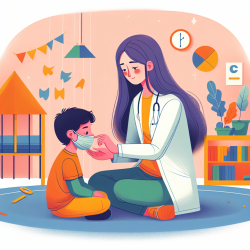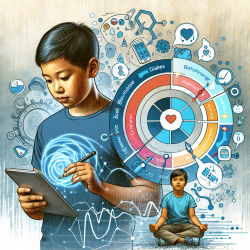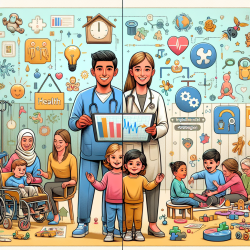Introduction
The COVID-19 pandemic has introduced numerous challenges, particularly for autistic children and adolescents. A recent study titled "Autistic children and adolescents with frequent restricted interest and repetitive behavior showed more difficulty in social cognition during mask-wearing during the COVID-19 pandemic: a multisite survey" sheds light on how mask-wearing impacts social communication in this population. As practitioners, understanding these findings can help us tailor interventions to improve outcomes for autistic children.
Key Findings
The study conducted by Tamon et al. (2022) involved 102 autistic children and adolescents from Tokyo, Japan. It explored the relationship between restricted interest and repetitive behavior (RRB) and the impact of mask-wearing on social communication during the pandemic. The research found that children with higher frequencies of RRB before the pandemic experienced more difficulties with mask-wearing and social cognition.
- Lower-order RRBs (e.g., sensory seeking) were linked to challenges in mask-wearing and recognizing emotions.
- Higher-order RRBs (e.g., restricted interests) were associated with discomfort and difficulties in emotion recognition while wearing masks.
Implications for Practitioners
These findings underscore the importance of understanding the sensory and cognitive challenges faced by autistic children in adapting to new norms like mask-wearing. Practitioners can enhance their skills by:
- Personalized Interventions: Tailor interventions to address specific RRB characteristics, focusing on sensory processing and emotional recognition skills.
- Collaborative Support: Work closely with caregivers and educators to create supportive environments that accommodate the sensory needs of autistic children.
- Further Research: Encourage ongoing research to explore additional strategies that can mitigate the impact of mask-wearing on social communication.
Encouraging Further Research
While the study provides valuable insights, there is a need for further research to explore long-term strategies that can assist autistic children in adapting to mask-wearing and other pandemic-related changes. Practitioners are encouraged to engage in research initiatives and collaborate with academic institutions to expand the knowledge base in this area.
Conclusion
Understanding the relationship between RRB characteristics and mask-wearing challenges is crucial for developing effective interventions for autistic children. By incorporating the findings of this study into practice, practitioners can better support the social communication needs of autistic children during and beyond the pandemic.
To read the original research paper, please follow this link: Autistic children and adolescents with frequent restricted interest and repetitive behavior showed more difficulty in social cognition during mask-wearing during the COVID-19 pandemic: a multisite survey.










